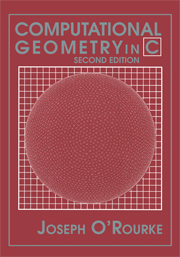8 - Motion Planning
Published online by Cambridge University Press: 05 June 2012
Summary
INTRODUCTION
The burgeoning field of robotics has inspired the exploration of a collection of problems in computational geometry loosely called “motion planning” problems, or more specifically “algorithmic motion planning” problems. As usual, details are abstracted away from a real-life application to produce mathematically “cleaner” versions of the problem. If the abstraction is performed intelligently, the theoretical explorations have practical import. This happily has been the case with motion planning, which applies not only to traditional robotics, but also to planning tool paths for numerically controlled machines, to wire routing on chips, to planning paths in geographic information systems (GIS), and to virtual navigation in computer graphics.
Problem Specification
The primary paradigm we examine in this chapter assumes a fixed environment of impenetrable obstacles, usually polygons and polyhedra in two and three dimensions respectively. Within this environment is the “robot” R, a movable object with some prespecified geometric characteristics: It may be a point, a line segment, a convex polygon, a hinged object, etc. The robot is at some initial position s (start), and the task is to plan motions that will move it to some specified final position t (terminus), such that throughout the motion, collision between the robot and all obstacles is avoided. A collision occurs when a point of the robot coincides with an interior point of an obstacle. Note that sliding contact with the boundary of the obstacles does not constitute a collision. A collision-avoiding path is called a free path. Often there are restrictions on the type of motions permitted.
Information
- Type
- Chapter
- Information
- Computational Geometry in C , pp. 294 - 346Publisher: Cambridge University PressPrint publication year: 1998
